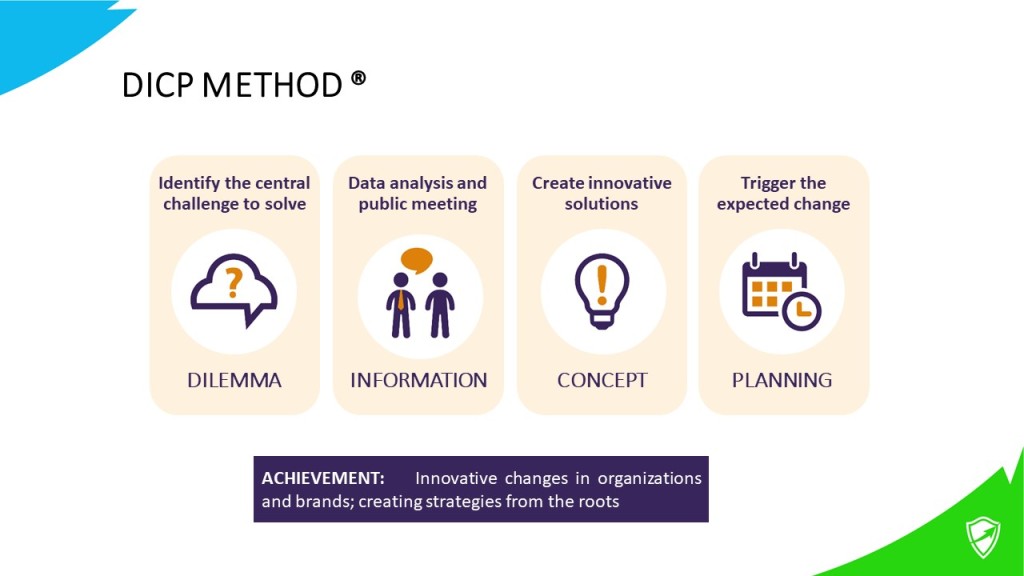This article deals with the importance of developing creative competencies in business
sciences professionals, specifically marketing. It seeks to show the scope and advantages found in the development of lateral thinking so as to achieve a more empathetic relationship between business managers and their target audiences within a globalized economic context requiring greater personalization and social emphasis on corporate actions.
This all is addressed from the parallel experience in creative and business schools, with the new approaches in business planning based on lateral, iterative, and cooperative thinking exercises as a starting point, and existing innovations as an example.
The goal is to generate model proposals that can be integrated into the curriculums, and can shorten the gaps expressed today by independent business schools as opposed to the typical university academic model, and also to provide for
the generational gaps existing in new consumers.
1. Business dilemma: Define the main Challenge
point of business management is the correct diagnosis of the situation on which to lay out the intervention. This can identify the longterm causes standardizing business policies, medium-term causes proposing strategic matrices and short-term causes acting on a tactical guide.
The long-term challenge a company faces and that calls for an intervention is
framed within the business strategy, which can be defined by resource supply and
production objectives, finance structure, commercial challenges, human capital or
geopolitical training.
These problem can arise from the market, affecting the whole sector or the
country, which may suppose category demand and offer transformations or complementary or supplementary market transformations. An example of this is the increase of the emerging sector’s expense capacity, which could be originating some demand sophistication, as is the case in school education (De la Barrera, 2013). Groups such as Intercorp have requested the innovation agency IDEO to design an educational proposal, with which they have created a franchise educational offer, located in social growth areas, leaving aside the location model in residential areas of traditional middle classes (Khan, 2012).
They offer a competitive price, lower than that of religious schools and with a particular pedagogy which promotes play and entrepreneurship.
A contextual analysis of the historical data, beyond the data collected ad hoc for the
study, was necessary in order to determine the cycles of the environmental factors or principles that allow to model behavioral patterns.
At this stage, we need to solve the environmental dilemmas involving the consumer and collaborator, seen as human beings immerse in a world of survival and existential decisions prior to the customer or worker function, for which the company and its products must adjust to their transcendental daily necessities, and not the other way around.
These dilemmas can also be sociocultural, as those generated by the economy, eco-sustainability, demographic and generational changes, citizen rights, conflicts, identity, among others. Businesses and their products should contribute to solving the challenges posed by changes in thought and sociodemographic variations. For example,
technology companies such as Google (Google. org, 2011) and Verizon (Verizon Wireless, 2014) have proposed, inside their organizations and as communication campaigns, the promotion of sciences and engineering for girls, adolescents and youngsters as part of a plan to balance the gender quota in the positions that imply
engineering and technology decisions.
2. Research: Knowing the causes and efects
In this proposal, the research process, both at the organization and the market level, should focus more on an exploratory task than a descriptive one. This proposal is justified by the fact that it tries to reveal new routes or be established before a situation of change.
In this regard, phenomenological design becomes important and enables to find
out people’s perceptions, the meaning of subjective experiences and collectively built
perspectives (Hernández, Fernández and Baptista, 2014). The phenomenological model makes it possible to understand how stimuli pondered by the industry and socialization
contingencies triggering phenomenological impressions subjectively impact on objects
and underlying experiences.
Phenomenology started to take the knowledge of other people seriously. This movement places the individual in the framework of a social context and reckons knowledge a collective building business.
Knowledge is never about a sole individual’s issue learning things about an external reality. Individuals who interact with each other end up imposing their constructs on reality: the world is constructed socially (Douglas and Isherwood, 1990, p. 79).
Impressions mediated by intuitions on people, facts and objects that become socialization norms in commercial or working environments. Consequently, studies do not focus on the individual or the world, but on the world as experienced by the individual (Hernández, et al., 2014); therefore, the expression of the meaning of these experiences enhances pursuits constructed from, in, to and with the individuals, appealing to the intuitive thinking principles, requiring saving lateral thinking beyond rationality; with extra-verbal dynamics to activate cultural, emotional and biological imprints. Among these techniques we have the use of collage, incomplete phrases, association of ideas, brand archetypes (based on Jung’s model), brainstorming, quick phrase ping pong, regressions, sensorial stimulations, among others (Quiñones, 2013).

3. Concept: An Big Idea like a Solution
It arises from the need of the business agent to get involved in the process of adapting the research findings to face the creation of concepts that explain the solution to the dilemmas analyzed.
An exact reflection of reality is not expected, rather a proposal for understanding
and a proper alternative arising from the intellectual and material resources available
to the business agent team in order to address this part of reality faced.
The application of lateral thinking exercises that demand leaving behind
conventional forms used to face business challenges is needed. Inspiration is sought
in the good practices of other companies, including other non-related categories in
the premeditated quest for changing current business practices. For this, creative techniques of art are employed, where the use of spatial, visual, and sensorial thinking is transferred to the business field.
In the same way, reflection on current issues and their context should
have transcendence and impact on society based on intervention.
Therefore, brands such as Absolut (Rivas, 2013) and BMW luxury cars (BMW
Group, 2014) resorted to the presence of renown plastic artists in their planning sessions to refresh new ideas in order to reinvent their brands and designs in a highly competitive and expenses market, where customer conservatism was an assumption. However, new inspiration sources were found through the artistic disruption for their new product presentations, communications and, also, for reinforcing their managers soft competencies towards empathizing better with their customers, as well as greater aesthetics.
4. Planning: Achieve Change
The final part of the creative process comprises organizing actions
to establish behavioral changes in the internal and external public, considering companies as organizations made up of human beings with human purposes. In the specific case of marketing management, based on satisfying customer needs, the step from scarcity to full satisfaction is essentially a behavioral change.
In addition, the differential perception of the brand, the satisfaction, loyalty and the buying action are behavioral changes.
Today, business model planning involves an active role, both from collaborators and
consumers, and in product improvement and the business model’s redesign. This is leading to the creation of planning skills in changing scenarios, and with flexible approaches according to the constant feedback with the audiences involved.
The social media and their influence in the perception of brands are having an
impact on the way communication decisions are made, as well as those interpreting their corporate strategy. Examples as those of Tottus’ “Buy one TV and if Peru gets to the
finals (Copa America), we’ll give you your money back” (Martinez, 2015) and BCP “Gay
Pride Day” (Vela, 2015), have represented the most renown marketing cases in Peru.
This is the result of the impact that networks have on the brand image, generating a
public pressure loop that directly appeals to company managers. This forced the
exertion of a direct leadership upon brands, business decisions and public management,
evidencing the need to decide rapidly about an agitated transforming context, as well as
the need to have the competencies to assume the company’s representation.
This planning process does not entail the repetition of formulas mechanically, but
an understanding process of each situation towards a final goal of change both for
external and internal customers.
In sum, we seek to train business agents in the development of an organization with greater flexibility in their processes and market adaptation, greater design sources for their products and communication, improvement generation, integration of collaborators into innovation processes, developing an alert attitude to market and competition trends, high performance teams in search of better practices beyond the competing category, talent search, a better image before authorities and specialized press due to innovation and its impact upon society and academia based on their own success or failure experiences.
Read the full Article: RIDU journal, UPC.
Author: Nicolás Ortiz Esaine, MSc. Ma
Asistant: Marlene Chocce, Psi

